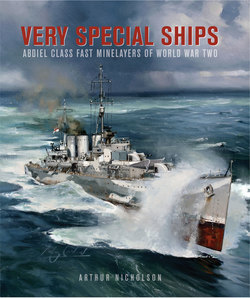Very Special Ships

Реклама. ООО «ЛитРес», ИНН: 7719571260.
Оглавление
Arthur Nicholson. Very Special Ships
Отрывок из книги
To F N ‘Norman’ Goodwin, author of Midshipman RNR, who encouraged me to write about the fast minelayers,
To all the Men Who Served in the Fast Minelayers and to their Fast Minelayers Association
.....
The Imperial German Navy engaged in minelaying from the first days of the Great War and to it goes the distinction of building the first fast minelayers designed and built as such, the Brummer and Bremse, the former completing just before the battle of Jutland in 1916 and the latter just after. Using turbines ordered for the Russian battlecruiser Navarin, they could develop 33,000 horsepower from coal and oil-fired boilers and were rated at a maximum speed of 28 knots, though 34 knots has been claimed for them. Rated as cruiser-minelayers, their normal displacement was 4385 tons, they were lightly armoured and were armed with 5.9in guns and 88mm anti-aircraft guns. It has been claimed they could carry from 360 to 450 mines, an astounding feat for ships of their size without an enclosed mining deck, but it was probably more like 120.22 With their three funnels and raked bow, the two ships were built to resemble the British Arethusa class light cruisers.
The Bremse and Brummer did carry out some minelaying operations, without spectacular results, but are best known for attacking and nearly annihilating a British-escorted convoy sailing between Scotland and Norway in October 1917. Their designed appearance worked well; at first mistaken by the convoy escorts for British cruisers, they got in the first shots and quickly sank the British destroyers Strongbow and Mary Rose and then most of the ships in the convoy. Both ships were interned at the end of the war and were scuttled with most of the rest of the High Seas Fleet at Scapa Flow in June 1919.23
.....